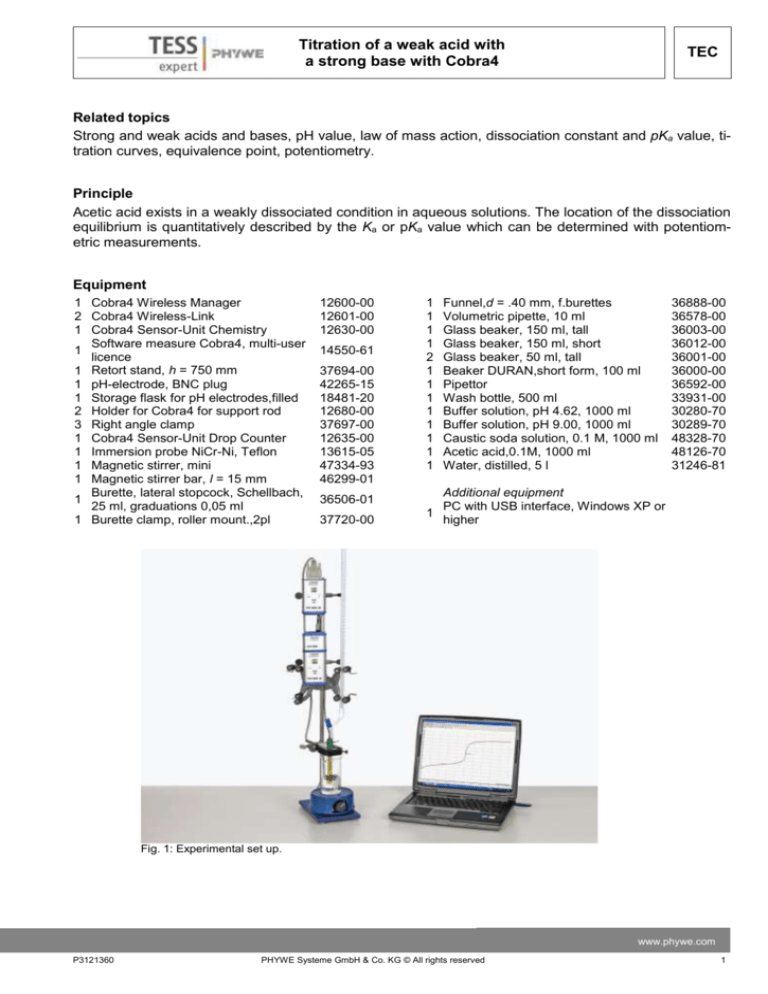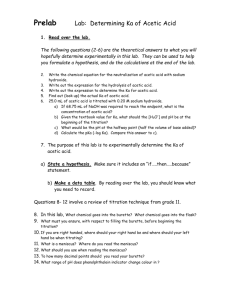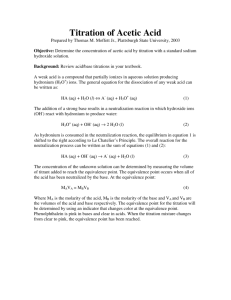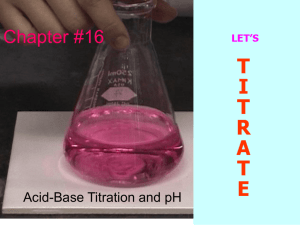
Titration of a weak acid with
a strong base with Cobra4
TEC
Related topics
Strong and weak acids and bases, pH value, law of mass action, dissociation constant and pKa value, titration curves, equivalence point, potentiometry.
Principle
Acetic acid exists in a weakly dissociated condition in aqueous solutions. The location of the dissociation
equilibrium is quantitatively described by the Ka or pKa value which can be determined with potentiometric measurements.
Equipment
1 Cobra4 Wireless Manager
2 Cobra4 Wireless-Link
1 Cobra4 Sensor-Unit Chemistry
Software measure Cobra4, multi-user
1
licence
1 Retort stand, h = 750 mm
1 pH-electrode, BNC plug
1 Storage flask for pH electrodes,filled
2 Holder for Cobra4 for support rod
3 Right angle clamp
1 Cobra4 Sensor-Unit Drop Counter
1 Immersion probe NiCr-Ni, Teflon
1 Magnetic stirrer, mini
1 Magnetic stirrer bar, l = 15 mm
Burette, lateral stopcock, Schellbach,
1
25 ml, graduations 0,05 ml
1 Burette clamp, roller mount.,2pl
12600-00
12601-00
12630-00
14550-61
37694-00
42265-15
18481-20
12680-00
37697-00
12635-00
13615-05
47334-93
46299-01
36506-01
37720-00
1
1
1
1
2
1
1
1
1
1
1
1
1
Funnel,d = .40 mm, f.burettes
Volumetric pipette, 10 ml
Glass beaker, 150 ml, tall
Glass beaker, 150 ml, short
Glass beaker, 50 ml, tall
Beaker DURAN,short form, 100 ml
Pipettor
Wash bottle, 500 ml
Buffer solution, pH 4.62, 1000 ml
Buffer solution, pH 9.00, 1000 ml
Caustic soda solution, 0.1 M, 1000 ml
Acetic acid,0.1M, 1000 ml
Water, distilled, 5 l
36888-00
36578-00
36003-00
36012-00
36001-00
36000-00
36592-00
33931-00
30280-70
30289-70
48328-70
48126-70
31246-81
Additional equipment
PC with USB interface, Windows XP or
1
higher
Fig. 1: Experimental set up.
www.phywe.com
P3121360
PHYWE Systeme GmbH & Co. KG © All rights reserved
1
TEC
Titration of a weak acid
with a strong base with Cobra4
Safety instructions
When handling chemicals, you should wear suitable protective gloves, safety goggles, and suitable
clothing. Please refer to the appendix for detailed safety instructions.
Tasks
1. Measure the alteration of the pH value during a titration of an aqueous solution of acetic acid with a
0.1 molar sodium hydroxide solution at constant temperature using the Cobra4 system.
2. From the titration curve read the equivalence point and determine the concentration of the acid.
Set-up and procedure
Set up the experiment as shown in Fig. 1.
Combine the Cobra4 Sensor Unit Chemistry and the Cobra4 Drop Counter with the Cobra4 Wireless-Links.
Attach them to the retort stand with the holders for Cobra4 and right angle clamps.
Connect the pH electrode to the pH input of the Cobra4 Sensor Unit Chemistry and the temperature
probe to temperature input T1.
Start the PC and connect the Cobra4 Wireless Manager with a USB socket of the computer.
After the Cobra4 Wireless-Links have been switched on, the sensors are automatically recognized.
Some ID numbers (01 and 02) are allocated to the sensors, which are indicated in the displays of
the Cobra4 Wireless-Links.
Call up the “measure” programme.
Click the “Unknown titration volume” button and confirm with “OK”.
Boot the experiment “Titration of a weak acid with a strong base with Cobra4” (experiment > open
experiment). The measurement parameters for this experiment are loaded now.
-
-
-
-
-
For calibration: Pour some buffer solution with pH 4.62 and pH 9.00
in two beakers.
Immerse the well-rinsed probe into one of the solutions.
In the Cobra4 Navigator under “Devices” double-click the “pH” symbol. Now you can change some measurement parameters.
Enter the pH value for the given solution under the menu point “Calibration” (Step 1, see Fig. 2).
Click the “Apply” button.
Repeat this procedure with the other buffer solution (Step 2).
Finish the calibration with “OK”.
Procedure: Position the magnetic stirrer under the stand.
Pipette 10 ml of the 0.1 molar acetic acid in the 150 ml beaker and
slip a magnetic stirring rod in.
Fill the burette up to the 25 ml mark with 0.1 molar sodium hydroxide
solution.
Fig. 2: Settings for the calibration mode of
the sensor.
2
PHYWE Systeme GmbH & Co. KG © All rights reserved
P3121360
Titration of a weak acid with
a strong base with Cobra4
-
-
-
-
-
-
-
TEC
Position the beaker containing the acetic acid on the magnetic stirrer so that the pH measuring electrode dips into the solution (Note: The pH electrode must dip at least so deep in the solution that the
diaphragm is completely immersed in the solution. Add more water if necessary).
Position the tap of the burette so that sodium hydroxide solution can drop into the beaker. Also ensure that individual drops will be recorded by the drop counter.
Adjust the stirrer to a medium stirring speed (Note: Do not allow the magnetic stirring bar to hit
against the measuring electrode.)
Start measurement with a click on
in the icon strip.
Add caustic soda solution drop-wise to the acetic acid from the burette. (Note: Take care that the
addition of the drops is not so rapid that the light barrier cannot register individual drops.)
When about 20 ml of caustic soda solution has been so added, close the tap of the burette and click on the icon to terminate measurement.
Send all data to “measure” (see Fig. 3). Save the measurement (File > Save measurement as…).
Fig. 4 shows the graph as presented by the programme. To
have the equivalence point displayed use
Fig. 3: Window which appears after
measurement.
.
Fig. 4: Measurement curve of a titration of 10 ml of 0.1 molar acetic acid with caustic soda (c = 0.1 mol/l).
Theory and Evaluation
- Acetic acid is a weak acid and caustic soda is a strong base. While sodium hydroxide dissociates
completely in aqueous solutions the acetic acid only dissociates partially.
CH3COOH + H2O
CH3COO- + H3O+
NaOH + H2O → OH- + Na+
-
The dissociation equilibrium of acetic acid in aqueous solutions can be described with the law of
mass action.
𝐾=
𝑎(CH3 COO− )×a(H3 O+ )
𝑎(CH3 COOH)×𝑎(H2 O)
(1)
With: K = equilibrium constant
www.phywe.com
P3121360
PHYWE Systeme GmbH & Co. KG © All rights reserved
3
TEC
Titration of a weak acid
with a strong base with Cobra4
a(X) = activity of substance X
-
Under the experimental conditions the concentrations of the particles is nearly equal to their activity:
𝑎(𝑋) ≈ 𝑐(𝑋)
𝐾=
-
(2)
𝑐(CH3 COO− )×c(H3 O+ )
𝑐(CH3 COOH)×𝑐(H2 O)
The concentration of water is constant with 55.55 mol/l at 298 K. So one gets a new equilibrium constant:
𝐾𝑎 = 𝐾 × 𝑐(H2 O) =
-
(3)
𝑐(CH3 COO− )×𝑐(H3 O+ )
𝑐(CH3 COOH)
(4)
This new equilibrium constant is a measure of the strength of the acid. Commonly one names the
pKa value:
𝑝𝐾𝑎 = −log(𝐾𝑎 )
-
(5)
The smaller the pKa value is, the stronger is the acid.
During a performed titration the formed oxonium and hydroxide ions react quantitatively with each
other forming water molecules.
H3O+ + OH- → 2 H2O
-
The pH value and the pOH value are measures for the concentrations of oxonium and hydroxide ions
in aqueous solutions.
pH = -log c(H3O+)
(6)
pOH = -log c(OH-)
(7)
pKw = pH + pOH = 14
-
(8)
In a neutral solution pH and pOH are equal.
pH = pOH = 7
-
(9)
One can determine the unknown concentration of a weak acid by observing the change of pH while
adding a strong base with a known concentration. To do this one have to determine the volume of
the strong base at the equivalence point.
c = n/V
(10)
n=c.V
(11)
with: c = concentration
n = number of moles
V = volume
-
4
Because the hydroxide ions reacts completely with the molecules of the weak acid the number of
PHYWE Systeme GmbH & Co. KG © All rights reserved
P3121360
Titration of a weak acid with
a strong base with Cobra4
TEC
moles of used hydroxide ions is equal to the number of moles of the acid at the point of equivalence:
NaOH + CH3COOH → Na+ +CH3COO- + H2O
-
So at the point of equivalence the following equation is valid:
n(OH-) = n(NaOH) = n(CH3COOH)
-
With equation (11) follows:
c(NaOH) : V(NaOH) = c(CH3COOH) . V(CH3COOH)
-
-
-
(13)
For the concentration of the weak acid at the equivalence point follows:
𝑐(CH3 COOH) =
-
(12)
𝑐(NaOH)×𝑉(NaOH)
𝑉(CH3 COOH)
(14)
The pH measurement is a potentiometric measurement and can only be carried out, when the potential of the indicator electrode is measured against that of a reference electrode. Both electrodes
are contained in single-rod pH measuring systems. A glass electrode is used as the indicator electrode. When this is immersed in an aqueous solution, a swelling layer (gel) is formed at the pH sensitive glass membrane. This also occurs at the inner side of the membrane, which is in contact with
a defined buffer solution, commonly of pH 7. According to the pH of the test solution, hydronium ions
diffuse either out of, or into, the outer swelling layer, whereby the potential of this layer changes. The
pH, and so also the potential, of the inner side of the glass membrane remains constant while this
occurs. With regard to the pick-up electrode, the same system is chosen as for the reference electrode (AgCl), so that the potential difference between the two electrodes is equal to zero. The voltage measured with the single-rod measuring system therefore results from the potential difference
between the inside and outside swelling layers of the glass electrode.
When the system is dipped into a test solution of pH 7, then a potential of 0 mV should be given, as
the inner potential is equal to the outer potential. Theoretically, when the pH changes by a single
unit, the voltage should change by 59.16 mV. This can be calculated using the Nernst equation,
which is as follows for hydrogen:
This rise in the pH-characteristic line is called the slope of the single-rod pH measuring system. The
slope of real pH measuring systems deviates like the zero point from the theoretical value given by
the Nernst equation.
www.phywe.com
P3121360
PHYWE Systeme GmbH & Co. KG © All rights reserved
5
TEC
Titration of a weak acid
with a strong base with Cobra4
Results
Fig. 4 shows the typical curve of a titration of a weak acid against a strong base.
At the beginning the pH value is not as low as that of a strong acid like hydrochloric acid. That’s because the acetic acid is only partly dissociated (about 1 %).
CH3COO- + H3O+
CH3COOH + H2O
-
-
During the performance of the titration the oxonium ions are neutralised because of the reaction with
the added hydroxide ions. The used oxonium ions are replaced because of further dissociation of
acid molecules. That’s why the pH value of the solution rises at the beginning of the titration.
Because of the logarithmical presentation of the concentration (see equation (6)) and because of the
establishment of a buffer area the rising of the curve is at first very low. The buffer system in this area consists of not dissociated acetic acid molecules and formed acetate ions.
NaOH + CH3COOH → Na+ +CH3COO- + H2O
-
-
Near the point of equivalence the pH value shows an abrupt rise because in this area more and
more of the acetic acid molecules are dissociated now and the buffer system doesn’t exist anymore.
The equivalence point of a titration at given conditions should be at 10 ml of added caustic soda solution.
The pKa value of the titration is calculated with the so called half equivalence point method. Here the
Henderson Hasselbalch equation, which describes the pH value of buffer solutions, is used:
𝑝𝐻 = 𝑝𝐾𝑎 − 𝑙𝑜𝑔
-
𝑐(HX)
𝑐(X− )
At the half equivalence point the concentrations of the acetate ions and the not dissociated acetic
acid molecules are equal:
c(HX) = c(X-)
𝑐(HX)
−𝑙𝑜𝑔 𝑐(X−) = 0
pH = pKa
-
(15)
(16)
(17)
(18)
The pKa value of acetic acid should be 4.75 at 298 K.
In the end of the titration the rise of the pH value is low again.
Notes
- Any other weak acid (e.g. propionic acid) can be used in this procedure in place of acetic acid.
- The pH electrode should be stored in a 3 molar potassium chloride solution when not in use.
Disposal
The diluted and neutralised solutions of the used acid and base can be disposed by rinsing into the
drain.
6
PHYWE Systeme GmbH & Co. KG © All rights reserved
P3121360
Titration of a weak acid with
a strong base with Cobra4
TEC
Appendix
Hazard symbol, signal word
Hazard statements
Precautionary statements
H290: May be corrosive to
metals.
P234: Keep only in original container
H290: May be corrosive to
metals.
P234: Keep only in original container
Caustic soda solution, 0.1 N
Attention
Acetic acid, 0.1 N
Attention
www.phywe.com
P3121360
PHYWE Systeme GmbH & Co. KG © All rights reserved
7
TEC
Titration of a weak acid
with a strong base with Cobra4
Room for notes
8
PHYWE Systeme GmbH & Co. KG © All rights reserved
P3121360





